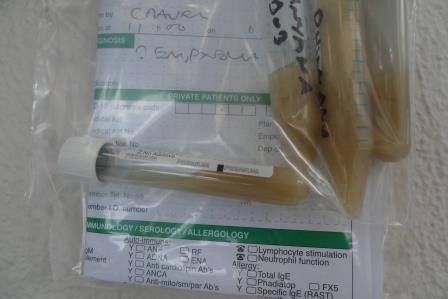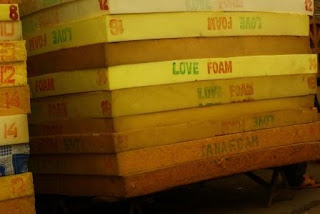 |
Women and children greeting myself and Ding (top right)
after we visited a boma. |
Christmas is upon us and that means two things at Holy
Cross: stabbings and circumcisions. To be fair, both happen all year round, but
there is a particular abundance of cases over the festive season. Why so many
circumcisions? In the Eastern Cape, getting a traditional snip is a big deal;
it is a coming of age thing, a boy becomes man affair, a rite of passage etc. I
am not too sure on the history of it all as I have been told several different
stories, but I am sure Google will give those interested a good answer.
 |
Two khwethas from the illegal
boma - we took them home to their
parents. |
For all this coming of age stuff, these young men risk a
lot. Last season (we call them seasons, there are two per year and both coincide
with the school holidays) we had one death and three auto-amputations – that’s
when a man loses his penis secondary to infection: a particularly grim affair. Someone
could go from attempting to become a man to
losing probably one of the biggest symbols of their man-hood. However, when done right, the ritual is an impressive
affair: Day one the foreskin gets chopped (traditional style) and put on the
initiate’s, a khwetha’s, forehead –
this is called the torch (something
about shining the light forward and no looking back – well, they’ll never get
their foreskin back); day 1-8 the khwethas stay inside a boma (a small hut
built for the occasion), aren’t allowed to go outside, get little food and
water and have to chant all night to scare off the witches; Day 8 they come
out, eat a freshly slaughtered goat and do man stuff (singing, collecting
firewood, putting clay on their face – that’s for witch protection – and so
forth); for the rest of their time, about a month, they live in the boma, do a
lot of chanting and get the occasional beating, possibly to show others how masculine
they are; at the end of it all, the boma is burnt, they wash in the river and
hey presto: MAN!
 |
| The kids were very excited after our trip to a boma. |
My colleague Ding teamed up with some local healthcare
workers, including a guy named Patrick who has done wonders for men’s
livelihoods, to improve the public health campaign on safe circumcisions. They
really have done a sterling effort and this season has seen only three
admissions (that’s rather low) at Holy Cross. I stepped in for Ding last week
and visited four camps, including one illegal site where I had my own police
escort. I felt exceptionally privileged to get a glimpse of this local
tradition, as without the guise of being a doctor on a special mission, no
regular person would be let in. To be honest, all of the penises looked pretty
nasty and it took some time to work out what was acceptable and what not. In
the end, only one boy got taken back to hospital for admission. Fingers crossed
he will make it back for his crossing the river ceremony, penis intact, and
leave Holy Cross a man.
****
 |
The young man - chest drain in, eviscerated bowels, about to
be wheeled to theatre. |
Circumcisions going wrong are one thing, stabbing and the
occasional gun shot is another. Matters have not been helped by our recent shortage
of intravenous fluids, which has made resuscitation rather difficult. Last week
a young guy was wheeled into casualty with his intestines out for all to see. His
friends were obviously concerned, as all five left straight away – maybe they
weren’t his friends at all. As I assessed him I noticed these findings: he was
heavily intoxicated with alcohol, in a fair amount of pain, had blood and air
in his right lung (a haemopneumothorax) from a very small stab wound on his
back and had eviscerated his bowels. So,
I popped a tube in his chest to drain the blood and air, gave him our last bag
of IV fluid and asked my boss to come help repair the small bowel lacerations
before sending him to our referral unit. All went pretty smoothly, I was
working with my favourite selection of nurses, which is always a bonus, and the
man was relatively stable. Unfortunately, he was bleeding into his abdomen and
needed major surgery – something we cannot do. I hear he made it to our
referral unit and I am led to believe he got to theatre, but he died later the
evening as a result of his injuries.
Why do I mention this case? It is not a particularly
uncommon occurrence. However, I just wanted to highlight the difficulties we
have with stabilising our critical patients (a lack of fluid and blood) and
getting them transferred for definitive care. A surgeon and anaesthetist would
be nice, better administration and management would be the dream.
 |
The man made it to the referral unit,
but died later of his injuries. In the red
is Mr Beja - one heck of a nurse. |
****
Working at Holy Cross constantly stretches my abilities, and
nerves for that matter. There is uncertainty every day and staying sane can be
tough at times, however I do seem to thrive off it. Saying this, there are occasions
when I wish I was in the comfort of a big NHS hospital with lots of support
around. I have just come off working 18 days straight, which included two 72
hour weekends on call. During the first weekend I was called to assess a mother
in labour at about 2 am on Friday night as the baby’s hand was coming out of
the cervix (for those that don’t know, head first is the usual way and occasionally
feet first, but hand first just doesn’t work). The midwife wasn’t wrong: as I
felt inside the mother’s vagina I was greeted by a tiny little handshake. I
tried to push the arm back, but the baby really didn’t want to let go, so we
went for a C-section. I performed the procedure and delivered a very healthy
boy. However, getting the new born out was probably the easiest part (normally,
it’s the hardest).
To start with, the uterus was rather vascular and bled quite
a lot. Bleeding is normal, but sometimes there is too much of it. Secondly, the
placenta was stuck (placenta accreta), so I had to manually remove it, which
took a few moments. Thirdly, well initially I thought there wouldn’t be any thirdly – the procedure was almost over.
I closed the uterus, tied the tubes (she had requested a tubal ligation as she already
had four other children) and stopped all the bleeding. Or, so I thought. As I
assessed the wound I saw a very unpleasant pulsatile ooze coming from one
corner. Turns out I severed the right uterine artery, something you really do
not want to do. This may have happened during the all too easy delivery of the baby. I couldn’t clamp it, so instead I tied a
catheter (a tube usually reserved to help people pee) at the base of her uterus
to tamponade the bleeding. As I, or my boss, were unable to ligate the artery,
I left the catheter in situ (a salvage procedure) to stop the bleeding, closed
her up and referred her to our obstetric unit 4 hours away for a hysterectomy.
This was a particularly good learning point for me – all
procedures carry risks and having a decent idea of how to prevent and manage
these outcomes helps. Tying the catheter at the base of the uterus is something
I have only read about, but at least I knew about it and I knew what to do: DON’T
PANIC. As a result, the lady made a good recovery.
****
By the way, “Cuttim Skin Blo Het Blo Kok” is Tok Pisin
(national language of Papua New Guinea) for circumcision.
I did part of my medical elective there as a student and have fond memories of assisting
circumcisions, mainly because as we would near the end of the procedure we
would say “clos to pinis now,” which means almost
done.
 |
| This young boy has disseminated varicella zoster virus (chicken pox) all over his body - inside and out. He is HIV positive and was neglected for quite some time, but now he is doing very well. |
 |
| This is a reminder card that I designed for HIV treatment initiation - there are still some changes to be made, as this is the pilot scheme, however, I was very excited to see it being used by one of our local clinics. |
 |
| A 10 year old boy weighing 10kg - this is something nobody should ever see. He is severely malnourished due to HIV and a probable underlying TB infection. Fortunately, he is improving and now weighs a spritely 14kg. |
 |
| Dancing in Durban at The Rainbow Restaurant - possibly one of my favourite haunts. I'm the guy in the black on the right - I'm now beardless. |






















































